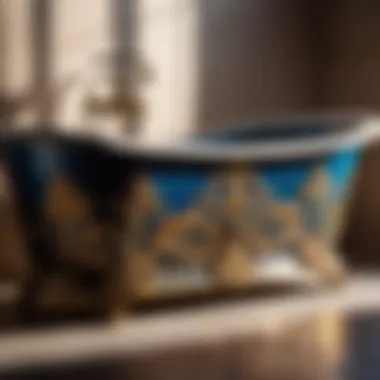Expert Guide: How to Re-Enamel Your Cast Iron Bathtub with Precision


Materials:
- Enamel paint specifically designed for bathtubs (2 quarts)
- Paintbrushes of various sizes for detailed work
- Paint roller for larger surface areas
- Masking tape
- Sandpaper (medium and fine grit)
- Paint thinner
- Protective gloves and goggles
- Respirator mask
DIY Steps:
- Preparation:
- Application:
- Drying and Curing:
- Clean the bathtub thoroughly to remove any dirt or grease.
- Use masking tape to protect surrounding areas from paint splatter.
- Sand the bathtub surface evenly to create a smooth base for the enamel.
- Wear protective gear before starting the enamel application.
- Stir the enamel paint thoroughly to ensure proper consistency.
- Use a paintbrush for edges and corners, and a roller for larger areas.
- Apply the paint evenly in thin layers to prevent drips and ensure even coverage.
- Allow the first coat to dry according to the manufacturer's instructions.
- Sand lightly between coats for better adhesion.
- Apply additional coats as needed, allowing each one to dry completely.
- Let the bathtub cure for the specified time before using.
Technical Aspects:
- Tools: Ensure proper ventilation in the workspace, use high-quality brushes for a smooth finish, and follow safety protocols when working with paint thinner.
- Timing specifics: Allow each coat of enamel to dry completely before applying the next one to prevent peeling or bubbling.
- Critical techniques: Maintain a consistent painting technique to avoid uneven application and drips, ensure sufficient drying time between coats for a durable finish.
DIY Project Process:
- Start Planning:
- Surface Preparation:
- Application Techniques:
- Troubleshooting Tips:
- Set aside a weekend for this project to allow ample time for preparation and drying.
- Double-check that you have all the necessary materials and tools before beginning.
- Thoroughly clean and dry the bathtub to ensure proper adhesion of the enamel.
- Use sandpaper to smooth out any rough patches or imperfections on the surface.
- Take your time to apply the enamel evenly, working in small sections to avoid streaks or clumps.
- Follow the specific instructions on the enamel paint for the best results.
- If you encounter drips or uneven patches, sand them lightly once the paint has dried, then reapply the enamel.
- Be cautious with the paint thinner and ensure proper ventilation to avoid any health risks.
Introduction


In the quest to revitalize a worn-out cast iron bathtub, understanding the process of re-enameling becomes not just a task but a transformative journey. This comprehensive guide is here to illuminate every intricate step, equipping you with the knowledge and tools required to breathe new life into your beloved bathtub. From the initial preparatory steps to the finishing touches, this guide serves as your beacon of knowledge, shedding light on the nuances of bathtub re-enameling.
Understanding Bathtub Re-Enameling
When we delve into the realm of bathtub re-enameling, we unravel the essence of restoration. The process involves stripping away the old surface layer to reveal the raw cast iron underneath. This meticulous endeavor serves as the foundation for the upcoming transformation, setting the stage for a vibrant and resilient new coating to be applied. By understanding the intricate nuances of this process, you gain a deeper appreciation for the craftsmanship involved in rejuvenating a cast iron bathtub.
Benefits of Re-Enameling a Cast Iron Bathtub
The decision to re-enamel a cast iron bathtub transcends mere aesthetics; it embodies a commitment to longevity and quality. By embarking on this journey, you not only breathe new life into your bathtub but also fortify its resilience against the test of time. The renewed enamel coating provides a protective barrier, shielding the cast iron from corrosion and wear. Furthermore, the revitalized surface enhances the overall ambiance of your bathroom, infusing a sense of luxury and sophistication into your daily routine.
Necessary Precautions Before Re-Enameling
Before diving into the re-enameling process, it is vital to exercise caution and meticulous preparation. Ensure proper ventilation in the workspace to safeguard against fumes emitted during the application of enamel coatings. Additionally, thorough cleaning and inspection of the bathtub surface are essential to address any underlying issues or damage that may compromise the longevity of the re-enameling results. Taking these necessary precautions lays the groundwork for a successful re-enameling endeavor, ensuring a final outcome that exudes durability and finesse.
Preparing for Re-Enameling
When considering re-enameling a cast iron bathtub, proper preparation is crucial to ensure a successful and long-lasting finish. The Preparing for Re-Enameling section in this guide acts as the foundation for the entire refinishing process. By focusing on specific elements such as gathering materials and tools, cleaning the bathtub surface, and repairing any damaged areas, you set the stage for a professional and durable result.
Gathering Materials and Tools
Before diving into the re-enameling process, it is essential to gather all the necessary materials and tools. This includes protective gear like gloves and masks, cleaning supplies such as degreasers and abrasives, as well as the enamel coating itself. Additionally, you will need tools for surface preparation like sandpaper, putty knives for repairs, and a high-quality brush or sprayer for application. Ensuring you have everything ready before starting will streamline the process and prevent delays.
Cleaning the Bathtub Surface
Cleaning the bathtub surface is a critical step in re-enameling. Start by removing any soap scum, mineral deposits, and grime using a non-abrasive cleaner. Then, thoroughly scrub the bathtub with a degreaser to eliminate any grease or oils that can affect the adhesion of the enamel coating. Rinse the bathtub thoroughly and allow it to dry completely before moving on to the next step. A clean surface is essential for the enamel to adhere properly and create a smooth finish.
Repairing Any Damaged Areas
Inspect the bathtub surface for any chips, cracks, or rust spots that need to be repaired before re-enameling. Use a suitable filler or epoxy to fill in any damaged areas, ensuring a level surface for the enamel coating. Sand down the repaired spots to blend them with the rest of the surface seamlessly. Taking the time to repair any imperfections will not only improve the appearance of the bathtub but also prevent further damage in the future.
Application Process


In the realm of re-enameling a cast iron bathtub, the application process stands as a pivotal phase that determines the outcome of the entire endeavor. This section delves into the meticulous steps involved in priming the bathtub, applying the enamel coating, and ensuring adequate ventilation for a flawless finish.
Priming the Bathtub
Priming the bathtub is a crucial initial step in the re-enameling process. It sets the foundation for the enamel coating to adhere properly to the cast iron surface, ensuring long-lasting durability and a professional finish. Before priming, thorough cleaning and sanding of the bathtub surface are imperative to remove any existing enamel remnants and create a smooth canvas for the new coating.
Select a high-quality primer designed specifically for use on bathtubs to ensure optimal adhesion. Apply the primer evenly using a paintbrush or roller, following the manufacturer's instructions for drying times between coats. Proper ventilation during priming is essential to facilitate the curing process and prevent any fumes from accumulating in the room.
Applying the Enamel Coating
The application of the enamel coating is a pivotal stage that demands precision and attention to detail. Choose a top-notch enamel product suitable for cast iron surfaces to guarantee a professional-quality result. When applying the enamel, use smooth, overlapping strokes to achieve even coverage and prevent drips or streaks.
Allow each coat of enamel to dry completely before applying additional layers to ensure a seamless finish. Depending on the specific product and manufacturer's recommendations, multiple coats may be necessary to achieve the desired opacity and durability. Careful application and patience during this stage are paramount to ensuring a flawless final outcome.
Ensuring Proper Ventilation
Proper ventilation is a non-negotiable aspect of the re-enameling process to safeguard both the integrity of the newly applied coatings and the health of individuals involved. Adequate ventilation helps dissipate fumes and odors emitted by the primer and enamel, creating a safe and comfortable working environment.
Open windows and doors to promote air circulation during priming and enameling stages. Additionally, using protective gear such as a respirator mask can minimize exposure to potentially harmful vapors. By prioritizing proper ventilation throughout the application process, you not only enhance the quality of the re-enameling but also promote a healthier working environment for all involved.
Finishing Touches
In the final stages of re-enameling a cast iron bathtub, the finishing touches play a crucial role in achieving a professional-looking result. Attention to detail during this phase ensures that the bathtub not only looks pristine but also functions optimally for years to come. One key aspect of finishing touches is the meticulous inspection of the tub surface to catch any imperfections or areas that may need additional touch-ups. This thorough examination guarantees that the enamel coating is smooth and uniform, enhancing the overall aesthetic appeal of the bathtub. Furthermore, ensuring that the edges and corners are neatly finished contributes to a polished look and reinforces the durability of the re-enamel job.
Additionally, proper post-enameling care is essential to maintain the newly refreshed surface. Providing adequate time for drying and curing allows the enamel to set properly, preventing premature wear and tear. Thoroughly adhering to the prescribed drying and curing times recommended for the specific product used is crucial to avoid compromising the finish. Moreover, reinstalling the bathtub fixtures with precision not only completes the aesthetic transformation but also ensures the functionality of the bathtub. This step involves securely attaching drains, faucets, and handles back in place, guaranteeing that the bathtub is fully operational and ready for use.
Furthermore, incorporating maintenance tips into the routine care of the re-enameled bathtub prolongs its lifespan and preserves its visual appeal. Simple practices like using non-abrasive cleaners, avoiding harsh chemicals, and regularly inspecting for signs of wear can prevent early deterioration and maintain the pristine condition of the bathtub. By embracing these finishing touches and conscientiously following post-enameling care guidelines, homeowners can enjoy a beautifully restored cast iron bathtub that exudes elegance and longevity.
Drying and Curing Time
After the application of the enamel coating, allowing adequate drying and curing time is paramount to ensure a durable and flawless finish. The timeframe for drying and curing can vary depending on the specific product used and environmental factors like temperature and humidity. Generally, it is recommended to allow the bathtub to remain undisturbed for at least 24-48 hours to facilitate proper drying. During this period, it is vital to control moisture levels in the room to prevent condensation from interfering with the curing process.


Adequate ventilation is essential to promote drying and avoid the formation of blisters or bubbles in the enamel coating. Air circulation aids in expediting the drying process and ensures even curing throughout the bathtub surface. While it may be tempting to expedite the process, it is crucial to resist using the bathtub until the enamel coating has fully cured to prevent premature damage to the finish.
Monitoring the drying and curing progress through visual inspection and following the manufacturer's guidelines regarding recommended time frames for before and after usage can help homeowners achieve an impeccably re-enameled cast iron bathtub that is both aesthetically pleasing and long-lasting.
Reinstalling the Bathtub Fixtures
Once the enamel coating has dried and cured, the next step in the re-enameling process is reinstalling the bathtub fixtures to complete the restoration. This task involves reattaching drains, faucets, handles, and any other removed components securely to the bathtub. Ensuring that fixtures are properly aligned and affixed not only enhances the visual appeal of the bathtub but also guarantees its functionality.
When reinstalling fixtures, it is essential to check for leaks or loose connections that may compromise the integrity of the bathtub system. Tightening connections and checking for smooth operation of faucets and handles is critical to prevent issues post re-enameling. Proper installation of fixtures also contributes to the overall aesthetic of the bathtub, creating a cohesive and polished look that complements the newly re-enameled surface.
By following manufacturer guidelines for specific fixture requirements and double-checking the installation for accuracy and stability, homeowners can ensure that their re-enameled cast iron bathtub not only looks stunning but also functions efficiently for years to come.
Maintenance Tips for Re-Enameled Bathtubs
Maintaining a re-enameled cast iron bathtub involves adopting specific care practices to preserve its pristine condition and extend its lifespan. For optimal maintenance, homeowners should avoid using abrasive cleaners and opt for gentle, non-abrasive solutions that will not damage the enamel coating. Regular cleaning intervals, focusing on removing dirt and grime buildup promptly, can prevent staining and maintain the bathtub's aesthetic appeal.
Furthermore, it is essential to avoid harsh chemicals that can erode the enamel finish and cause deterioration over time. Implementing a soft cleaning cloth or sponge and mild detergents will help ensure that the re-enameled bathtub retains its luster and remains resistant to wear. Regular inspection for cracking, chipping, or any signs of damage is advisable, as addressing issues promptly can prevent extensive repairs in the future.
In addition to routine cleaning, homeowners should be mindful of usage practices that may impact the longevity of the re-enameled bathtub. Avoiding abrasive materials and sharp objects that can scratch the surface, and being cautious with heavy objects that may dent the enamel, are simple yet effective ways to preserve the bathtub's visual appeal. By adopting these maintenance tips and integrating them into their cleaning routine, homeowners can enjoy a beautifully re-enameled cast iron bathtub that remains in pristine condition for years to come.
Conclusion
In this comprehensive guide on re-enameling a cast iron bathtub, we have covered every aspect from understanding the process to applying the final coat. Re-enameling a cast iron bathtub is a meticulous and detailed task that requires patience and precision. The importance of the conclusion lies in the culmination of efforts that result in a beautifully restored bathtub that shines with renewed life.
Throughout this guide, we have highlighted the benefits of re-enameling a cast iron bathtub, such as prolonging its lifespan, enhancing its appearance, and saving on the cost of replacing the bathtub. By following the necessary precautions, preparing the surface effectively, and applying the enamel coating properly, you can achieve professional-quality results that will transform your bathtub.
Moreover, the conclusion section emphasizes the significance of proper drying and curing time, reinstalling fixtures correctly, and providing maintenance tips to ensure the longevity of the re-enameled bathtub. These finishing touches are essential in completing the re-enameling process and maintaining the bathtub's pristine condition for years to come.
Enjoy Your Newly Re-Enameled Bathtub
After completing the re-enameling process meticulously, it's time to bask in the joy of your newly restored cast iron bathtub. The transformation from a worn-out, dull surface to a gleaming, fresh one is truly gratifying.
As you step back and admire your work, remember the effort and attention to detail that went into each step of the re-enameling process. The properly dried and cured enamel coating now provides a durable and lustrous finish that enhances the overall look of your bathroom.
To fully enjoy your newly re-enameled bathtub, ensure to follow the maintenance tips provided in this guide. By cleaning the bathtub with gentle solutions, avoiding abrasive materials, and promptly addressing any chips or damages, you can preserve the pristine appearance of the re-enameling work for years to come.
Embrace the luxurious ambiance that your re-enameled bathtub brings to your bathroom space. It's not just a functional fixture but a statement of elegance and care that elevates the aesthetic appeal of your home.







